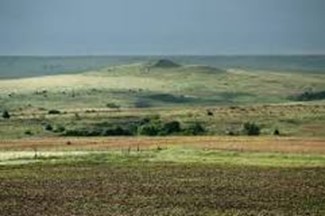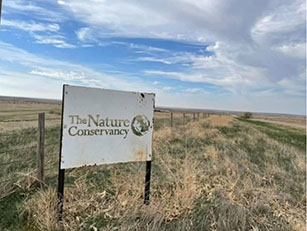
The Nature Conservancy
Smoky Valley Ranch combines an 18,000-acre working cattle ranch with native grasslands and a wildlife refuge. It is home to the Lesser Prairie Chicken, bison, mule deer, pronghorns, mule deer, black-tailed prairie dogs, green toad, swift fox, ferruginous hawks, golden eagles, burrowing owls and black-footed ferrets and other native wildlife. The 5.5-mile hike takes you through vast open grasslands and around towering chalk formations, providing miles of uninterrupted scenery. The hike will take about two hours, depending on how often you stop to admire the ranch’s natural beauty. The Smoky Valley Ranch is about a 5-hour drive west of Kansas City. It is located in southern Logan County, 12 miles south of W Highway 83 and 38 miles north of Scott City.
Smoky Valley Trail Route
The Smoky Hills Trail was established at the end of the Civil War to carry goods and travelers, including gold miners, from Fort Leavenworth to Denver. The trail served as an east-west highway and was traveled by the Arapaho and Cheyennes, the 7th Calvary of George Custer (including William F. Cody), and the 10th Calvary (the Buffalo Soldiers). The Butterfield Overland Dispatch stage line also passed through the area. Fort Leavenworth, Kansas’s first “city,” was established on the bluffs of the Missouri River by Colonel Henry Leavenworth in 1827, making it the oldest permanent settlement in Kansas. It is also the second oldest active United States Army post west of Washington, D.C. It has a rich history and significance in protecting the western frontier by escorting travelers, keeping the peace between the settlers and Native American tribes, and training soldiers, which continues to the present day. The modern-day Smoky Valley Scenic Byway is only 60 miles long, and you can read more about it on the Smoky Valley Scenic Byway page.

Crossing the Smoky Hill River Valley

It feels liberating to walk through the vast prairie.

Western Kansas is a beautiful part of our big state that those of us who live in the eastern half rarely have the opportunity to explore. If you are a hiker, nature lover, or interested in fossils (attention - dinosaurs!), make the time to visit western Kansas and hike among beautiful rock formations and endless prairies. Smoky Valley Ranch is just one of several stops in western Kansas that can be explored.

Even in the internet era, if you want to stay off the grid, be prepared for no signal. However, creating a map with all the stops and points of interest along the way on your grand Wild West of Kansas expedition is easy!
Water Everywhere
Eighty million years ago, during the Cretaceous period, this dry and desolate landscape was at the bottom of the ocean, which is hard to imagine now.
What remained on the bottom of the ocean for millions of years makes western Kansas a magnet for paleontologists, geologists, and dinosaur hunters from all over the world.

Yes, there are sea shells in the middle of the U.S. continent! No fossils can be removed from the area.

Caves like these are inhabited by black-tailed prairie dogs, burrowing owls, and black-footed ferrets.
The scenery changes with each season and is never boring. Avoid summertime visits because there are no shaded areas to escape the summer heat, and watch out for ticks and snakes; this is a rattlesnake country!

In August 2024, another 374 acres of grassland were added to the southern end of the existing 18,749 acres.

The bottom of the ocean from 80 million years ago can be unearthed in chalk bed formations like these.

Tough prairie flowers are survivors of the rugged terrain.

There is no restroom or water provided. Be sure to bring plenty of water any time you visit.
Collecting anything from the ground and taking them as souvenirs is strictly prohibited. If you discover artifacts or fossils, you are welcome to take photographs, but please leave them where you found them and notify the Nature Conservancy at kansas@tnc.org or 785-233-4400.
If you ever find yourself in western Kansas, make time to hike through the Smoky Valley Ranch.
Resources:
Smoky Valley Ranch Hiking Trails
Magda Born
mborn@kckpl.org
Community Services Librarian
913-295-8250 ext 1103

Exploring Kansas by Mil Penner
Mil Penner tells how he discovered surreal landscapes, Bengal tigers, talking tombstones, and a windmill garden. In the west he traces Horace Greeley's famed stage coach trip through the badlands of the Smoky River Valley, and he climbs Mount Sunflower with the Rattlesnake Lady. In the east he searches for ghost towns and explores the opulence of frontier Atchison.

Kansas Then & Now by Monroe Dodd
Fourth in the Kansas City Star series of Then & Now books, featuring an old black and white photograph on the left page with a current color photograph on the right page of the same building or location.

Tales of Western Kansas by Amy Lathrop
A collection of the stories the old people told and possibly the reader heard as he grew up here.

Kansas archaeology by Robert J. Hoard
From Kanorado to Pawnee villages, Kansas is a land rich in archaeological sites--nearly 12,000 known--that testify to its prehistoric heritage. This volume presents the first comprehensive overview of Kansas archaeology in nearly fifty years, containing the most current descriptions and interpretations of the state's archaeological record.

Pioneers of Western Kansas by Myrtle D. Fesler
Fesler's affectionate eulogy of those stalwart and indefatigable American men and women who crossed the plans in [riaries schooners during the westward trek after the Civil War and who stubbornly held to their purpose and contributed towards shaping the American Dream into reality.